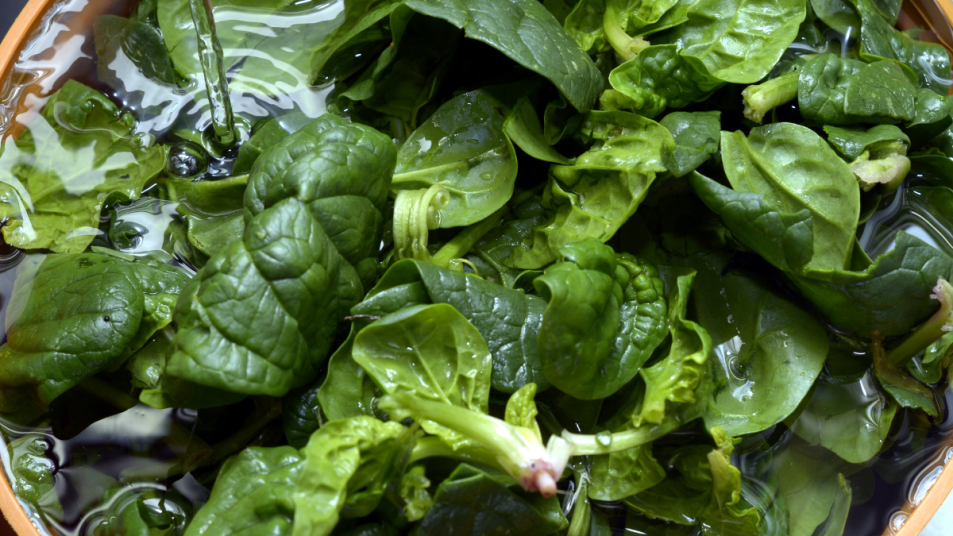How to Clean Spinach, Kale, and Other Leafy Greens to Avoid Harmful Pesticides

When it comes to fruits and vegetables, spinach, kale, collards, and mustard greens are some of the dirtiest produce you can buy in terms of pesticides. Besides the chemicals, leafy greens are usually covered with dirt, sand, silt, and other grime.
Don’t believe us? In a 2021 Environmental Working Group (EWG) report titled the “Dirty Dozen” list, leafy green varieties landed the number two and three spots (strawberries are number one). Luckily, taking a few simple steps will clean up your produce. Added bonus: Your greens will last longer, too.
Why are leafy greens so dirty compared to other produce?
Why do we use pesticides in fruits and vegetables in the first place? There are some major benefits, including aiding in pest control and repelling or killing bugs, fungi, or other creatures that might burrow in our food. Unfortunately, depending on the type and amount of pesticides in any item, there can be side effects like trouble breathing, skin rashes, inflammation, or other health problems. There are additional concerns about long-term exposure to pesticides.
Leafy greens in particular are problematic. In fact, spinach has 1.8 times as much pesticide residue by weight than any crop that EWG researched, and one sample of kale, collard, and mustard greens had up to 20 different pesticides in it. Moreover, previous work found that 60 percent of kale samples sold in the US contained pesticide residue that may cause cancer. Buying organic produce is a great way to get vegetables free of pesticides, but if that’s not an option, how you clean your produce is very important.
In terms of physical dirt, given that leafy greens are often grown directly in, well, dirt, it should come as no surprise that there tends to be a lot of to clean. Plus, since these greens have many crevices and root systems spread throughout, sand, dirt, and silt have a tendency to embed all over individual leaves and stems.
While farmers, manufacturers, and supermarkets may do a preliminary rinse of their produce before customers pick it up, it takes a far deeper clean to get off all of the grime. (Click through to learn how leafy greens like spinach ward off vision-robbing macular degeneration.)
How do you get them clean?
While some methods may differ slightly depending on the leafy green or the person, there’s a general routine you can follow whether you’re cleaning spinach, kale, lettuce, collard greens, or something else.
Here’s what to do:
- Run your leafy greens under the tap for an initial quick rinse as soon as you get home from the grocery store. Cut out their stems or stalks, as much of the dirt and sand is trapped in them. To make things easy and less wasteful, you can wash stems separately and use them in vegetable stocks and other recipes later.
- Check your leaves to see if there are any bits that are already starting to go brown or soggy and dispose of them. Then, chop your produce into larger chunks. This will make the process of cleaning them way easier than if they’re still intact.
- Place your greens in a salad spinner filled with cold water and crank it several times. If you don’t have a salad spinner, fill a large pot with cold water and place your greens in it, then toss them for a minute or two.
- Once you’ve used your salad spinner or just tossed them in a large pot, transfer your greens to another bowl or pot that includes a 10 percent saltwater solution and let it sit for 20 minutes. After those 20 minutes are up, drain your greens using a colander and lay them on a towel or several paper towels. Lightly pat them dry.
- Once you’re sure everything’s dry, place your greens in containers lined with paper towels at the bottom. This will help soak up additional moisture and prevent your greens from getting soggy. Store them in the coldest part of your fridge for anywhere from seven to 10 days depending on the veggie.
If you want to do even more to specifically get pesticides off of your vegetables, other common hacks include soaking those greens in a one-part vinegar, four-parts water solution for 20 minutes, or soaking your vegetables in a mixture that contains a ratio of 100 ounces of water to one ounce of baking soda for 15 minutes.
While the process might seem more involved than just running your greens under the sink for five seconds, you’ll not only make sure you’re protecting your health, but your food will taste better too. Another bonus: You’ll never take a bite of spinach or kale and feel those tiny sand grains in your mouth ever again.













